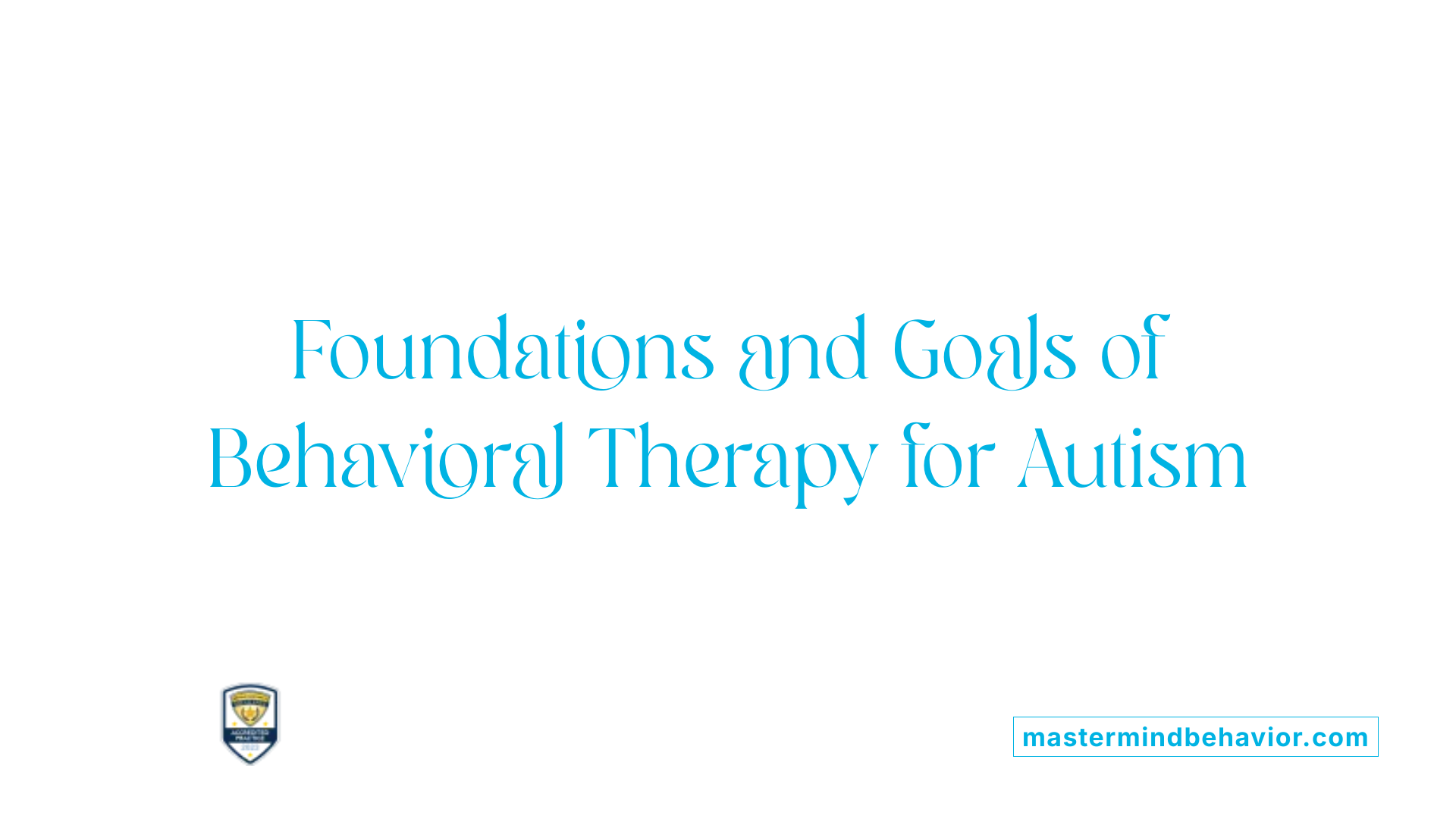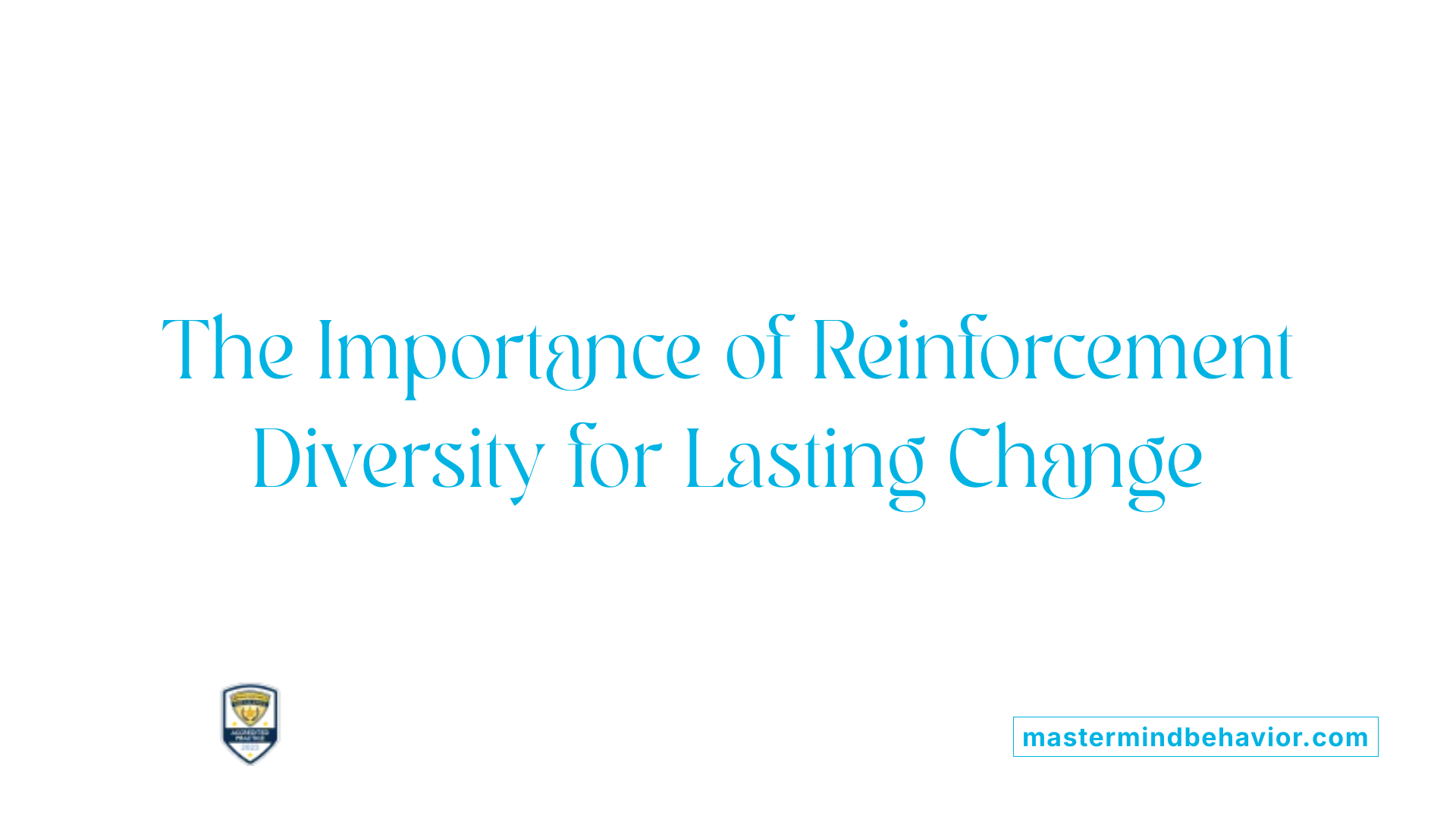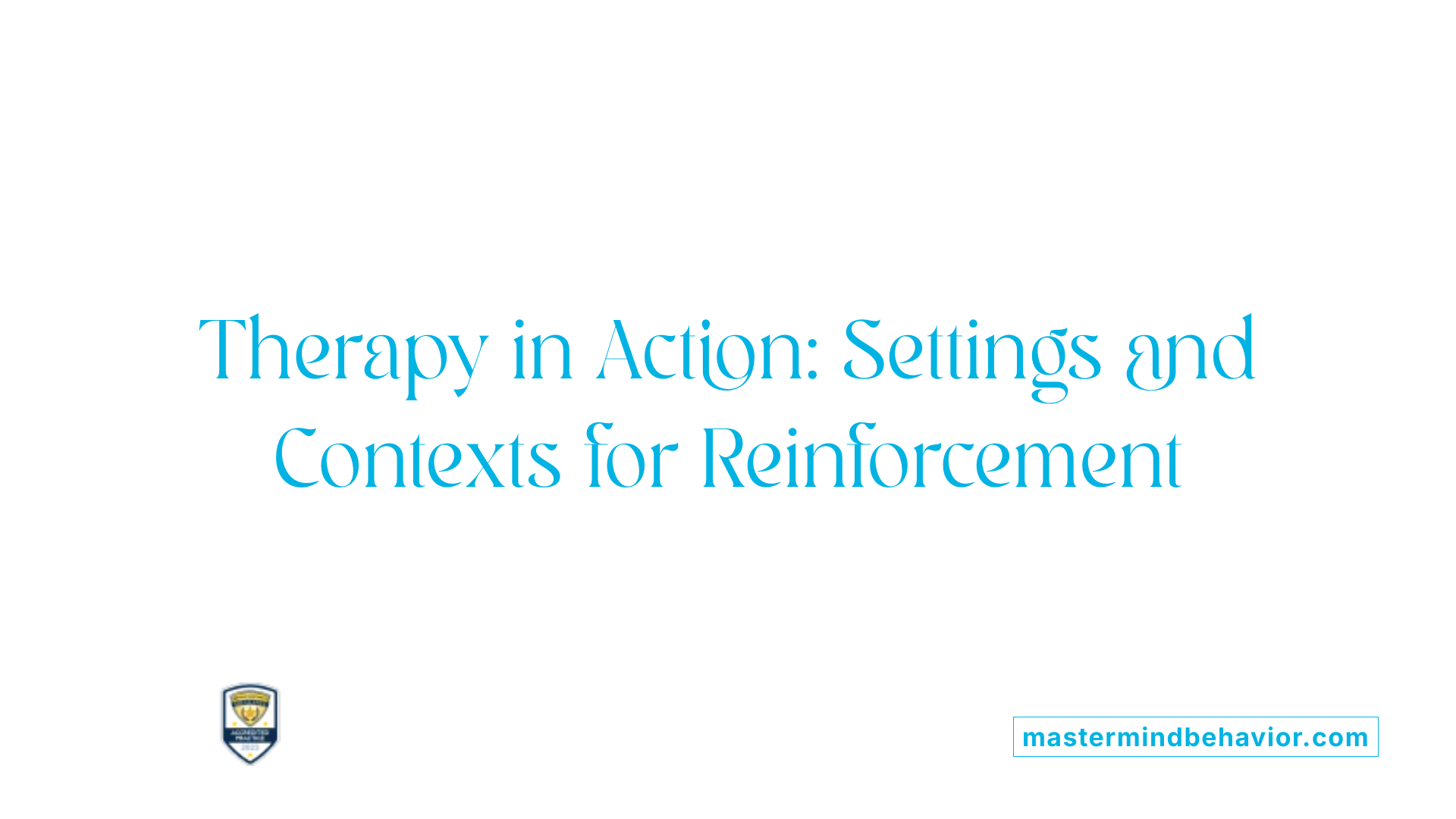Understanding the Power of Diverse Reinforcement in ABA
Applied Behavior Analysis (ABA) therapy is widely recognized as a premier approach for supporting individuals with autism spectrum disorder (ASD). Central to its success is the use of reinforcement techniques to encourage positive behavioral changes. This article explores the critical role that diversity in reinforcement strategies plays in maximizing the effectiveness of ABA programs, tailoring treatment to individual needs, and ultimately fostering independence and improved quality of life for children with autism.
Behavioral Therapy for Autism: Foundations and Goals

What is behavioral therapy for autism?
Behavioral therapy for autism, primarily based on Applied Behavior Analysis (ABA), uses scientific principles of learning and behavior to support individuals with autism spectrum disorder (ASD). Its goal is to enhance social skills, communication, and daily living by encouraging positive behaviors and reducing problematic ones. Techniques such as positive reinforcement and analysis of antecedents and consequences (A-B-Cs) guide this therapy.
How does ABA serve as a primary therapy approach?
ABA stands as the leading method within behavioral therapy for autism. It is evidence-based and tailored to each child’s strengths, needs, and preferences. Qualified professionals, including Board Certified Behavior Analysts (BCBAs), develop individualized treatment plans. ABA therapy is flexible, taking place in multiple settings like home, clinics, schools, and social groups, ensuring consistent skill development across environments.
What are the goals of behavioral therapy?
The therapy aims to replace challenging behaviors with adaptive, positive ones, fostering improved communication, social interaction, concentration, and daily skills. It supports independence, self-efficacy, and confidence in individuals with ASD. Through measurable goals using SMART criteria, progress is tracked and treatment modified to meet evolving needs.
How are individualized treatment plans created?
Each ABA program involves a thorough assessment of the child’s current abilities and challenges. Based on this, specific, measurable, achievable, relevant, and time-bound (SMART) goals are set, reflecting the child’s unique situation. Family involvement is integral to ensure collaboration and support, which enhances treatment effectiveness. Plans are continuously evaluated and refined for optimal outcomes.
How ABA Therapy Helps Children With Autism
How does applied behavior analysis (ABA) therapy help individuals with autism?
Applied Behavior Analysis (ABA) therapy aids children with autism by using evidence-based strategies to teach new skills and enhance existing ones. Rooted in the science of behavior, ABA focuses on increasing positive behaviors like communication, social interaction, and daily living skills while reducing behaviors that may interfere with learning or social integration.
What are the principles of ABA therapy?
ABA therapy operates on principles such as positive reinforcement, where desirable behaviors are encouraged by presenting rewarding stimuli. This process strengthens neural pathways via neurotransmitters like dopamine, promoting habit formation. Individualized assessment sets measurable, SMART goals that guide tailored treatment, making therapy personalized and compassionate. Ethical practices ensure respect for autonomy and dignity, with ongoing collaboration between families and professionals.
How does ABA help in teaching new skills and improving existing abilities?
ABA employs various behavior modification techniques to support skill development. These methods include prompting and fading, task analysis, and generalization, helping children acquire and apply skills across different settings. Positive reinforcement encourages appropriate emotional regulation and social behaviors, fostering independence and confidence. Early intensive intervention demonstrated by multiple hours of therapy weekly yields better long-term developmental outcomes.
How is ABA therapy individualized?
Each ABA program is customized to the unique needs, strengths, and interests of the child. A qualified Board Certified Behavior Analyst (BCBA) leads the process, involving family participation to enhance treatment effectiveness. Therapy settings can vary from home and clinics to schools and social groups, ensuring learning in real-life environments.
What are some examples of ABA techniques used?
- Discrete Trial Training (DTT): Structured teaching sessions with repeated trials.
- Pivotal Response Training (PRT): Naturalistic methods targeting pivotal areas like motivation.
- Verbal Behavior Intervention (VBI): Focuses on language acquisition.
- Picture Exchange Communication System (PECS): Uses pictures to improve communication.
- Video Modeling and Peer-Mediated Social Skills Training: Enhance social learning.
These approaches are supported by research and help build communication, social skills, concentration, and daily living abilities.
| Aspect | Description | Impact |
|---|---|---|
| Individualized Treatment | Tailored plans with SMART goals and family collaboration | Addresses unique needs for better outcomes |
| Reinforcement Techniques | Positive reinforcement, prompting, fading | Encourages desired behaviors and skill acquisition |
| Variety of Settings | Home, clinic, school, social groups | Promotes generalization and real-world application |
| Ethical Practice | Respect for autonomy, minimizing distress | Builds trust and ensures dignity throughout therapy process |
The Role of Reinforcement in ABA Therapy

What is positive reinforcement and why is it central to ABA therapy?
Positive reinforcement is a foundational principle in ABA therapy that involves presenting a desirable stimulus immediately after a targeted behavior. This increases the likelihood that the behavior will occur again in the future. The strategy is widely used to teach new skills such as communication, social interaction, and independence.
How does reinforcement work neurologically?
Positive reinforcement leverages neuroscience by triggering the release of neurotransmitters like dopamine. This release strengthens neural pathways associated with the desired behavior, essentially 'wiring' the brain to repeat these adaptive behaviors. This neurological process supports learning by reinforcing behaviors on a biological level.
What types of reinforcement are used in ABA therapy?
ABA uses various reinforcement strategies including:
- Positive reinforcement: Adding a pleasant stimulus to encourage behavior.
- Negative reinforcement: Removing an aversive stimulus to increase desired behavior.
- Prompting and fading: Gradually reducing assistance to foster independence.
- Task analysis and shaping: Breaking down complex skills into manageable steps and reinforcing successive approximations.
- Behavior contracts and peer-mediated strategies: Using agreements and social models to promote behavior change.
This combination of techniques is tailored based on individual needs, strengths, and preferences.
How does reinforcement impact learning and behavior?
Reinforcement techniques in ABA directly promote emotional regulation, social skills, and adaptive behaviors. They help replace problematic behaviors with positive alternatives, improving concentration, daily living skills, and overall functioning. Through consistent and personalized reinforcement, individuals develop greater independence, self-efficacy, and confidence.
By emphasizing individualized, empathetic care guided by research, ABA therapy ensures that reinforcement strategies are effective and meaningful, supporting long-term growth and skill acquisition in children with autism and other behavioral challenges.
Why Reinforcement Diversity Matters in ABA Programs

Importance of Using Varied Reinforcers
In ABA therapy, the use of a range of reinforcement types is crucial to maintain effectiveness. Variety in reinforcers prevents children from becoming bored or disinterested in the stimuli, which could reduce the impact of positive reinforcement. By continually introducing different favorable consequences such as tokens, praise, or access to preferred activities, therapists help sustain motivation over time.
Matching Reinforcers to Individual Preferences
ABA programs emphasize tailoring reinforcement strategies to each child's unique interests and preferences. This personalized approach increases the likelihood that the reinforcement will be meaningful and effective. Therapists assess preferences regularly and adjust rewards accordingly, ensuring the reinforcers align with what truly motivates the child.
Preventing Satiation and Loss of Effect
Repeated exposure to the same reinforcer can lead to satiation, where the reward loses its appeal and no longer encourages the desired behavior. By varying reinforcers and combining different types, ABA therapy avoids this pitfall. This dynamic approach helps maintain the strength and consistency of behavior change.
Enhancing Motivation and Engagement
Using diverse and individualized reinforcers enriches the learning environment, encouraging children to participate more fully in therapy. Motivation is boosted when children anticipate rewards that are valued, increasing their engagement in acquiring new skills such as communication, social interactions, and independence. This also supports the development of emotional regulation and social skills.
The strategic use of varied reinforcement methods, matched to personal preferences and updated frequently, is fundamental to the success of ABA therapy. It aligns with the broader goals of fostering self-efficacy and confidence, ensuring interventions remain effective and meaningful throughout the child's development.
Personalizing Reinforcement Strategies for Optimal Outcomes
How is data used to select reinforcement strategies in ABA therapy?
ABA therapists employ a data-driven approach to select reinforcement strategies. They systematically collect and analyze behavioral data to identify which reinforcers are most effective for each individual. This continuous assessment allows therapists to tailor interventions that best motivate the child, ensuring improvements in targeted behaviors. Precision in data tracking helps modify reinforcement plans when goals are met or when a strategy becomes less effective.
How do strength-based approaches enhance reinforcement in ABA?
Strength-based approaches focus on leveraging the individual's existing interests and abilities to enhance motivation. By identifying what a child enjoys or excels at, therapists use these strengths as powerful reinforcers. This approach promotes engagement and fosters a positive therapeutic environment, making learning more enjoyable and effective.
In what ways are children’s interests and preferences incorporated into reinforcement?
Therapists collaborate closely with families to understand a child's unique likes and dislikes. These preferences inform the selection of reinforcers, such as favorite toys, activities, or social interactions, used during therapy sessions. Incorporating personal interests not only increases the likelihood of behavior change but also supports the child’s overall well-being and confidence.
How are reinforcers adjusted over time?
Reinforcers are regularly reviewed and adapted based on ongoing data analysis and the child’s evolving preferences. As skills improve, therapists may fade certain reinforcers or replace them with new ones to maintain motivation and encourage independence. This dynamic adjustment ensures the continued success of behavioral interventions throughout the course of therapy.
By integrating data-driven methods, focusing on strengths, incorporating personal interests, and dynamically adjusting reinforcers, ABA therapy maximizes effectiveness and fosters meaningful progress for each child.
Settings and Contexts for Implementing Reinforcement

What Settings Are ABA Therapies Implemented In?
ABA therapy is flexible and can be provided in a variety of settings, including home-based programs, clinic-based sessions, school environments, and social skills groups. This versatility allows therapists to reach children in familiar places where they learn and develop daily, helping maximize the therapy's effectiveness.
How Is Generalization Across Environments Supported?
One important goal of ABA therapy is to generalize learned behaviors so that children can apply skills across different settings. Practitioners carefully design interventions that promote transferring skills from one environment to another, ensuring children's abilities grow beyond therapy sessions.
What Is the Role of Family Involvement?
Families play a critical role in ABA therapy, with many programs emphasizing collaboration and active family participation. Support for families includes resources and community engagement, fostering a family-first approach that strengthens treatment outcomes and helps maintain consistent reinforcement of behaviors at home.
How Do Professionals Collaborate with Families?
Qualified professionals such as Board Certified Behavior Analysts (BCBAs) lead therapy and work closely with families to tailor intervention plans. This partnership ensures treatment goals align with the child's needs and family preferences, fostering open communication and ongoing support throughout the process.
The Professionals Behind Effective ABA Reinforcement

Who Provides Behavioral Therapy Services for Autism?
Behavioral therapy for autism is delivered by a team of specialized professionals, primarily Board Certified Behavior Analysts (BCBAs) and Registered Behavior Technicians (RBTs). BCBAs take charge of designing personalized ABA programs tailored to each child’s unique needs, ensuring that treatment adheres to research-based practices.
RBTs and licensed therapists work under the guidance of BCBAs to implement these programs. Their hands-on role involves delivering therapy sessions, using various ABA techniques, and collecting important data to monitor progress.
Training and Qualifications
Practitioners in this field are extensively trained. BCBAs, for example, hold at least a bachelor's degree, complete advanced certification, and accumulate supervised clinical experience. RBTs also undergo specialized training and certification to provide direct intervention.
This rigorous preparation equips professionals with the skills to deliver evidence-based care, maintain ethical standards, and adapt strategies based on individual behavioral assessments.
Program Design and Supervision
BCBAs lead the program design by conducting individualized assessments and developing SMART goals aimed at enhancing social, communication, and daily-living skills. They continually supervise therapy delivery, analyze progress through detailed record-keeping, and modify treatment as needed.
Supervision also ensures that therapy remains compassionate, ethical, and aligned with the latest scientific research.
Family Training and Support
A defining aspect of ABA therapy is family involvement. Professionals actively train family members in applying behavioral strategies at home. This collaborative approach strengthens treatment effectiveness and encourages generalization of skills across different environments.
Support extends beyond training; families gain access to resources and community engagement, fostering a ‘family-first’ approach that enhances the overall success of ABA interventions.
Technology and Innovation Enhancing Reinforcement Diversity
How are apps and virtual reality used in ABA therapy?
The integration of apps and virtual reality in ABA therapy represents a cutting-edge approach to enhancing reinforcement strategies. These technologies provide dynamic, engaging platforms for delivering positive reinforcement, which is a core principle of ABA.
Apps can offer interactive games and activities tailored to individual learning goals, making reinforcement more immediate and visually appealing. Virtual reality immerses children in simulated scenarios where they can practice social skills, communication, and daily tasks in a safe, controlled environment.
How do data collection and analysis improve reinforcement?
Data collection and analysis are vital in refining ABA therapy. Therapists use technology to track each child's responses to different reinforcement methods in real time, gathering detailed information about which strategies are most effective.
This data-driven approach helps practitioners modify therapy plans promptly, optimizing reinforcement schedules and techniques. By analyzing patterns and outcomes, therapists ensure that interventions are personalized and evidence-based.
How is technology used to tailor reinforcement strategies?
Technology enables ABA practitioners to customize reinforcement strategies based on individual preferences and behavioral responses. For example, automated systems can adjust the type, frequency, and timing of reinforcements according to a client's progress and engagement levels.
Moreover, digital tools can incorporate an individual's interests, aligning with strength-based approaches to boost motivation and participation. This targeted reinforcement enhances learning efficiency and fosters greater independence.
What are the future directions in reinforcement techniques within ABA therapy?
Looking forward, the future of reinforcement in ABA therapy lies in further technological innovation and interdisciplinary collaboration. Advances are expected in AI-driven tools that personalize reinforcement dynamically and virtual reality environments that simulate complex social interactions.
Additionally, research into neurological effects related to reinforcement may lead to refined methods that better leverage brain science, maximizing positive behavioral outcomes. The continuing evolution aims to create more responsive, engaging, and effective ABA interventions tailored to each child's unique needs.
Ethical Considerations and Family Collaboration in Reinforcement Application
Respecting Dignity and Autonomy
ABA therapy upholds the dignity and autonomy of individuals by tailoring interventions to each child's unique needs and preferences. Respect for the person means minimizing coercion and promoting choice whenever possible, ensuring that the child remains an active participant in their own treatment journey.
Minimizing Distress
Practitioners prioritize the emotional well-being of children by using compassionate methods that reduce discomfort and distress during therapy. Techniques are selected and adjusted based on ongoing assessment to create a supportive and encouraging environment.
Transparent and Collaborative Goal Setting
Goal-setting in ABA therapy is a transparent process involving both professionals and families. Treatment objectives are defined clearly using measurable criteria, fostering a shared understanding and active collaboration between therapists and families to maximize progress.
Family-First Approach and Community Support
Family involvement is central to effective ABA therapy. Programs emphasize partnerships with families, providing resources and community engagement opportunities that empower caregivers. This family-first approach ensures consistency across settings and strengthens the support network around the child, enhancing treatment outcomes.
Embracing Reinforcement Diversity to Empower Individuals with Autism
Diversity in reinforcement strategies within ABA programs is more than a therapeutic technique; it is a cornerstone that fosters meaningful progress tailored to the unique profiles of individuals with autism. By incorporating a variety of reinforcers that align with personal interests, utilizing data-driven adjustments, and engaging families across multiple environments, ABA therapy maximizes motivation, skill acquisition, and behavioral improvement. As technology evolves and ethical practices remain central, the future of ABA looks poised to continue delivering compassionate, effective, and individualized support that empowers children with autism to thrive with greater independence and confidence.
References
- Navigating Neurodiversity: ABA Therapy's Role in Autism...
- The Importance of ABA Interventions
- The Power of Positive Reinforcement in ABA Therapy
- Exploring the Importance of ABA Therapy for Autism
- Applied Behavior Analysis (ABA)
- ABA Therapy Goals: 25 Practical Examples & Timelines
- Behavioral Management Therapy for Autism | NICHD









